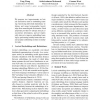Free Online Productivity Tools
i2Speak
i2Symbol
i2OCR
iTex2Img
iWeb2Print
iWeb2Shot
i2Type
iPdf2Split
iPdf2Merge
i2Bopomofo
i2Arabic
i2Style
i2Image
i2PDF
iLatex2Rtf
Sci2ools
ACL
2015
2015
Learning Lexical Embeddings with Syntactic and Lexicographic Knowledge
We propose two improvements on lexical association used in embedding learning: factorizing individual dependency relations and using lexicographic knowledge from monolingual dictionaries. Both proposals provide low-entropy lexical cooccurrence information, and are empirically shown to improve embedding learning by performing notably better than several popular embedding models in similarity tasks. 1 Lexical Embeddings and Relatedness Lexical embeddings are essentially real-valued distributed representations of words. As a vectorspace model, an embedding model approximates semantic relatedness with the Euclidean distance between embeddings, the result of which helps better estimate the real lexical distribution in various NLP tasks. In recent years, researchers have developed efficient and effective algorithms for learning embeddings (Mikolov et al., 2013a; Pennington et al., 2014) and extended model applications from language modelling to various areas in NLP including lexical semant...
| Added | 13 Apr 2016 |
| Updated | 13 Apr 2016 |
| Type | Journal |
| Year | 2015 |
| Where | ACL |
| Authors | Tong Wang, Abdelrahman Mohamed, Graeme Hirst |
Comments (0)

